The Microsoft Surface Laptop 2 Review: Surface Essentials
by Brett Howse on March 28, 2019 8:00 AM EST- Posted in
- Laptops
- Microsoft
- Surface
- Surface Laptop
- KBL-R
- Surface Laptop 2
GPU Performance
Intel’s UHD 620 iGPU is pretty well known by now, offering 24 execution units and a great video decoder. Where Intel lacks the grunt for 3D gaming, they do make it up in battery life, especially on video playback. But there is no getting around the fact that it offers relatively little in the way of 3D performance.
With some extra competition here now in the guise of AMD’s Ryzen platform with integrated Vega, hopefully we’ll see some fresh ideas from Intel in the near future. A few players, such as Huawei, have skirted the issue by adding a NVIDIA GeForce MX class GPU, but the added cost and complexity of that is not something that many manufacturers have gone. Microsoft does offer some serious GPU performance in their Surface Book lineup, featuring either a GTX 1050 or GTX 1060, but in the Surface Laptop 2 it’s just the UHD 620.
3DMark
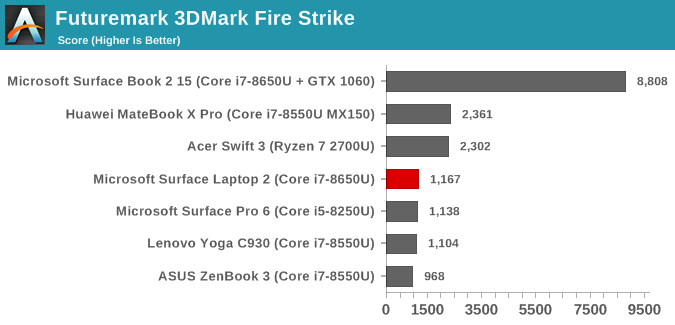
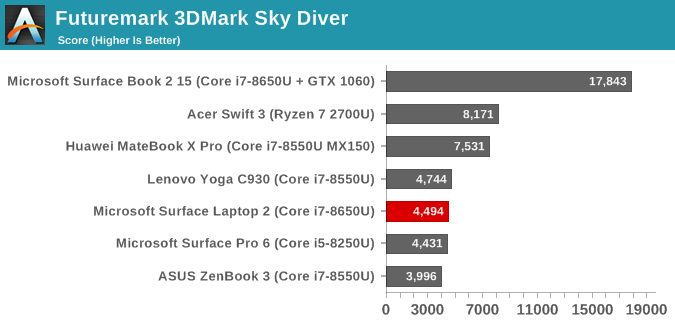
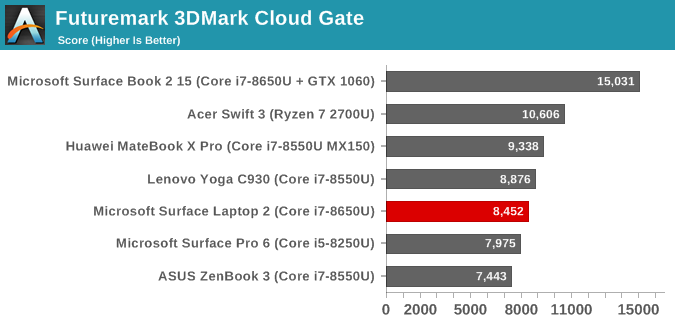
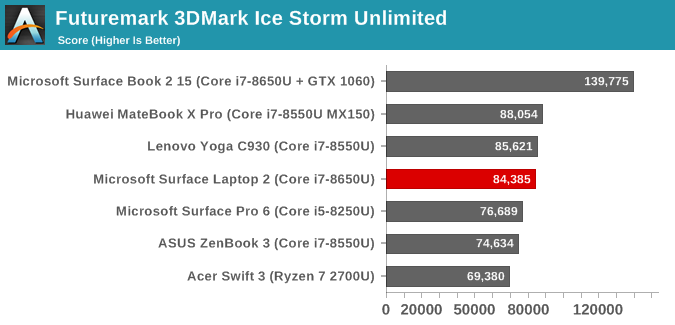
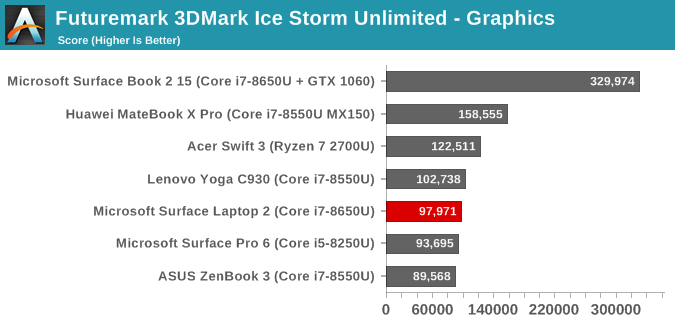
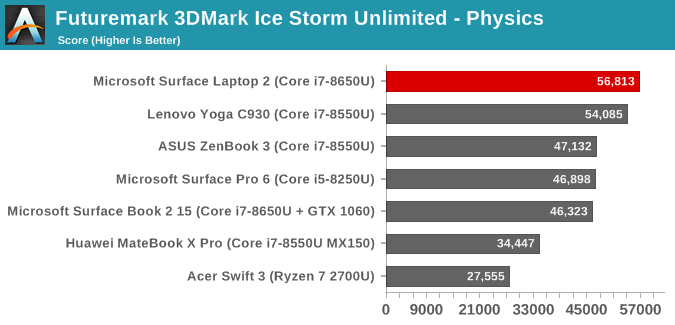
3DMark offers several scenes with increasing levels of complexity to test a wide range of GPUs. Fire Strike is the highest level we test on laptops, followed by Sky Diver, Cloud Gate, and Ice Storm Unlimited which is a test that can also be run on smartphones and tablets, although the results are not directly comparable. As the scene complexity goes down, CPU performance is more important.
On Fire Strike, Intel’s UHD 620 is really unusable, scoring under half of an AMD Ryzen powered laptop, or the MX150 in the Huawei MateBook. Those results continue, but as noted above the devices get more CPU limited as the scenes get less complex, which is why you can see the UHD 620 outperforming Vega on Ice Storm Unlimited.
GFXBench
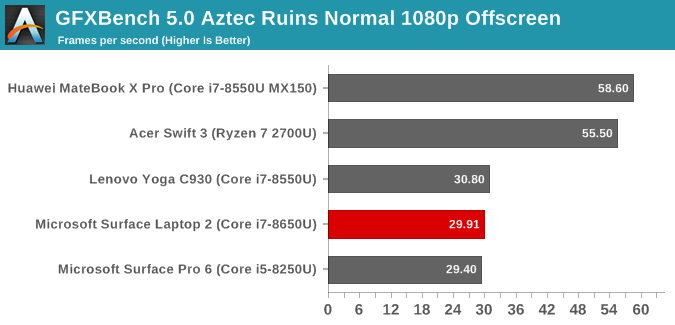
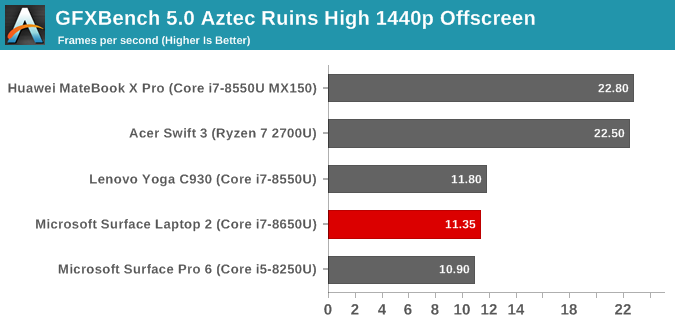
With version 5.0 of GFXBench, Kishonti now offers DX12 benchmarks, which is great to see. The previous version used OpenGL which is all but gone from the PC landscape, and not relevant. As expected though, UHD 620 is well behind AMD’s Vega or the MX150.
Dota 2
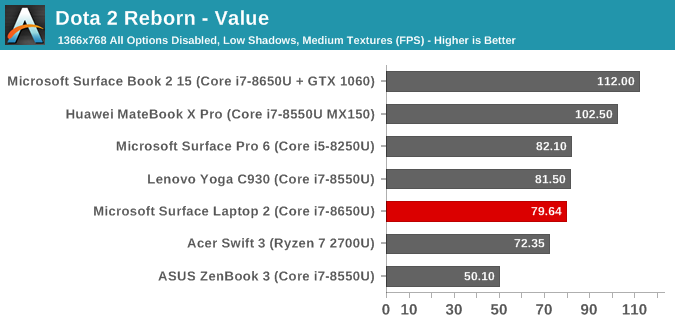
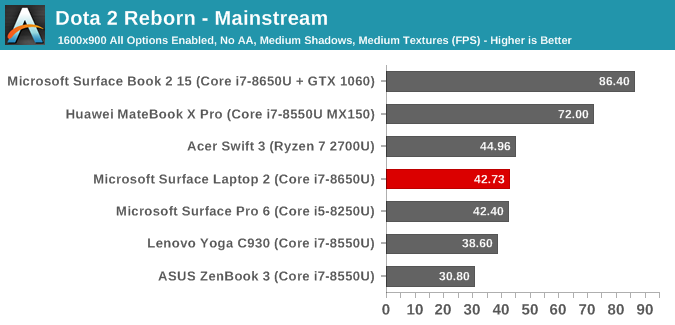
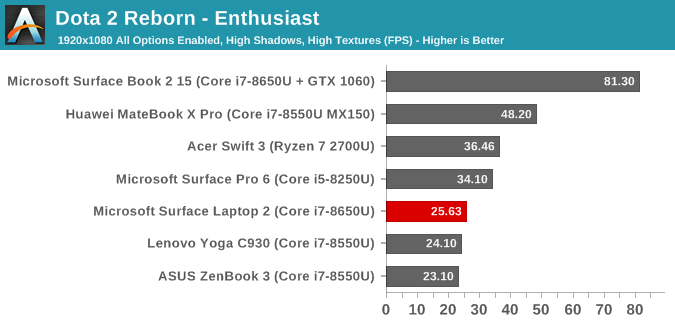
Valve’s Dota 2 offers a wide range of performance options which allows it to run well enough on even integrated graphics, assuming you’re OK turning the options down. The game tends to be CPU capped with any real GPU though, which is why a GTX 1060 compares to a MX150 on value settings. The Surface Laptop 2 doesn’t offer any surprises here though. It’s very playable on value, somewhat playable on mainstream, but unplayable on enthusiast.
GPU Conclusion
The Surface Laptop 2 isn’t a gaming system by any means. The 3:2 aspect ratio can be funky on some games, and only offering Intel’s UHD 620 holds it back quite a bit. It would have been nice to see Microsoft add something like the MX150 to this for a performance bump, but if you do need some GPU performance they’d likely rather sell you a Surface Book.
Storage Performance
Microsoft made the move to BGA SSDs a while back, and that continues with their Laptop 2. The review unit features a SK Hynix BC501. The advantage of a BGA SSD is size. The BGA drive is just 16 mm x 20 mm, compared to a typical M.2 2280 which is 22 mm x 80 mm. The BGA model is much thinner as well, so it makes for easier packaging, at the cost of not being able to replace or upgrade the drive later. If you are looking for any Surface device, be aware that you need to purchase your storage up-front.
The other disadvantage is that the BGA models only offer a PCIe x2 link, rather than the typical x4 link you’d see on a mid-to-high-end M.2 drive, which limits the maximum bandwidth to half of what we might see elsewhere. In real-world use, that’s not too limiting, since random reads and writes never max out the interface anyway, but it does mean that sequential speeds are capped. Even so, it’s still an order of magnitude faster than any spinning drive.


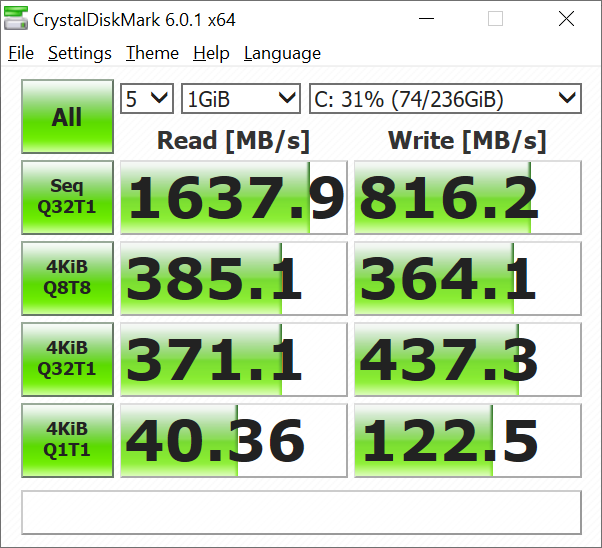








59 Comments
View All Comments
Manch - Monday, April 1, 2019 - link
True no need to fanasize. Just look at Anands bench. Intel has 2 8 series 6C/8T. One cost 100$ more and has a 100mhz base clock bump over the 2k series Zen. Boost clock is also higher. They trade blows but the 2k series zen wins more than it loses. Then look at the 8086 which is double the price and for double the price it beats the 2k series Zen. Fair enough. Looking at the benchmarks, the key gake away is as I said earlier, Intel has the speed still and its enoigh to offset the efficiency gains of Zen's SMT. Unless Intel is holding back soemthing good, the 3rd series Zen will take the Rchitecture from trading blows and winning some to handing out L's.eddman - Thursday, March 28, 2019 - link
What do you mean by "effective"?mr_tawan - Thursday, March 28, 2019 - link
In the other hand, if I wait for half a year and found that the CPU I bought is not much better comparing to the ones available 6 months before, I'd be very disappointed.That is something happened to me before.
That said, I don't think this will be the case for Ice Lake CPUs.
tipoo - Thursday, March 28, 2019 - link
Hopefully that's what they were waiting on for a redesign with USB C/TB3maus92 - Thursday, March 28, 2019 - link
I replaced a MacBook with this machine. The MacOS was having issues with backups and reliable / persistent internal network connections, so this purchase is an experiment. So far, so good. My only complaint is the trackpad - the one on the MacBook was far superior.Eletriarnation - Thursday, March 28, 2019 - link
A bit of a nitpick, but I think this statement in the first page isn't 100% correct:"...16 GB, which happens to be the maximum supported by Intel’s current U-series processors."
This limitation probably only applies to DDR3, as ark.intel.com advertises a maximum of 32GB and DDR4 support for these models too.
Ryan Smith - Thursday, March 28, 2019 - link
To be clear, that passage is solely talking about LPDDR3. Which is why it's mentioned as such in the full sentence."models ship with a minimum of 8 GB of LPDDR3, with high-end and upgraded models increasing that to 16 GB, which happens to be the maximum supported by Intel’s current U-series processors."
Gunbuster - Thursday, March 28, 2019 - link
FIFY: "The Surface Laptop 2 is built out of glue"Should mention nothing is serviceable so you better buy the extended and accidental damage warranty and plan on that "accident" when the battery degrades to 60% in true surface style.
Irata - Thursday, March 28, 2019 - link
Small correction:The article says "Model Tested: Core i7-8650U 8GB 256GB $1299", however further down under pricing, you see:
"256 GB Intel Core i7 with 8GB of RAM: $1599"
Ryan Smith - Thursday, March 28, 2019 - link
D'oh. Fixed. Thanks!